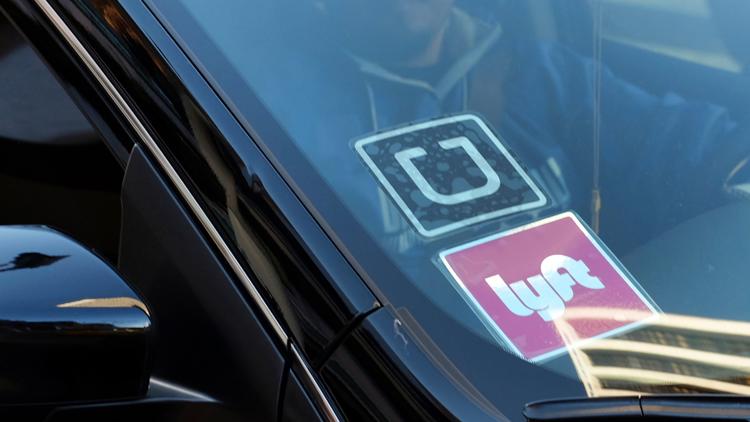CALIFORNIA, USA — This story was originally published by CalMatters.
Ninety percent of miles logged by Uber and Lyft drivers in California will have to be in electric vehicles by 2030 under a state mandate to be considered Thursday.
The California Air Resources Board’s proposed regulation aims to curb the climate impacts of emissions from ride-hailing trips. It’s an ambitious target: In 2018, electric vehicles accounted for less than 1% of miles traveled by Uber and Lyft drivers in California.
The big question for the gig-economy fleets is: Who will pay for the cleaner cars?
Representatives of Uber and Lyft told the air board that they support the 90% mandate, but are pushing for state funding and flexibility if they encounter delays meeting the targets.
“We support this regulation and we support the ambitions that it sets out,” said Adam Gromis, global lead on sustainability policy at Uber. “We do think that there’s work to be done in terms of pairing and marrying the regulation side with supportive policies that can ensure a fair transition for drivers.”
Lyft wrote in a letter to the board: “While we are pleased to see aggressive environmental targets, we are disappointed that the efforts of the past years have culminated in metaphorical sticks with no carrots.”
READ MORE:
Environmental groups, labor advocates and drivers are calling for California regulators to ensure that the companies, not the drivers, cover the costs of electrifying their fleets.
Yearly costs for ride-hailing companies and drivers, including electricity and home chargers, could reach roughly $400 million in 2030, according to an air board staff report. But staff predicts that savings, including on gasoline and maintenance, will far outstrip them — leading to net benefits of $215 million in 2030.
Still, an air board analysis of driver ZIP codes estimates that about 56% of ride-hailing drivers could be from low-income or disadvantaged communities who may not be able to afford the switch to an electric vehicle.
“The companies should pay all expenses for all the vehicles, all the time. But that’s not happening,” said Nicole Moore, who drives a plug-in hybrid part-time for Lyft in the Los Angeles Area and is on the organizing committee for Rideshare Drivers United. “The cost of the fleet is on the drivers, the cost of the fuel is on the drivers, everything is on the drivers.”
Moore called for any state incentives to go directly to drivers. “This is going to basically be a green badge of honor for Lyft and Uber, when it’s the drivers that are paying for this conversion,” Moore said. “And it’s not right.”
If the regulation is approved by the board, in two years 2% of miles traveled by Uber and Lyft drivers fleetwide must be in electric vehicles, ramping up to 30% in 2026 and 90% in 2030. The 90% mandate would require electrifying less than half of the high-mileage drivers’ vehicles.
It would cut greenhouse gas emissions by 1.81 million metric tons from 2023 to 2030, plus nearly 400 tons of smog-forming gases and particles. That’s equivalent to removing nearly 400,000 cars from California’s roads.
The fleet is fast-growing so the environmental impact is increasing. Rideshare drivers logged about 1.2% of the total miles traveled by light-duty vehicles on California’s roads in 2018, up from 0.05% in 2014. Uber and Lyft dominate the ride-hailing sector, which produces about 1% of the greenhouse gases from light duty cars and trucks in California. Overall, transportation is the biggest greenhouse gas polluter in California.
READ MORE:
The fleets have outsized climate impacts, pumping out about 50% more carbon dioxide in 2018 than the average personal vehicle for every mile traveled with a passenger, according to an air board analysis.
That’s because ride-hailing fleets travel a lot between trips or while waiting for a fare. These so-called “deadhead miles” without a passenger account for about 40% of total miles traveled by ride-hailing vehicles.
Factoring in public transit, the Union of Concerned Scientists pegs the impact even higher — estimating that ride-hailing trips produce 69% more planet-warming pollution than the forms of transportation they replace.
A 2018 law authored by state Sen. Nancy Skinner, a Democrat from Berkeley, tasked the air board with setting standards to curb greenhouse gas emissions from ride-hailing companies. The California Public Utilities Commission will be in charge of enforcing them.
The rule also calls for cutting the companies’ carbon dioxide emissions from miles traveled with passengers to zero by 2030, partially by using credits earned by integrating public transit into their apps and improving walkability and access to biking.
Dave Weiskopf, senior policy advisor for NextGen California, a progressive advocacy group founded by Tom Steyer, said the standards aren’t aggressive enough in the early years.
Starting too slowly, he said, will allow the companies to lean on state and federal subsidies as well as on higher-income drivers who were already going to purchase electric vehicles, rather than provide incentives to help lower-income drivers afford them.
“Then the companies can free-ride off of investments that its employees are making — sorry, contractors are making,” Weiskopf said. “The idea that it’s important to set weak standards in the early years in order to protect drivers is actually exactly backwards.”
READ MORE:
An earlier proposal, released last summer, would have electrified 60% of vehicle miles traveled.
But Lyft already pledged to electrify its entire fleet by 2030, and Uber has the same goal for vehicles in US, Canadian and European cities, with full electrification by 2040. Uber also said it would commit $800 million to help drivers transition.
Joshua Cunningham, the air board’s branch chief of advanced clean cars, said it’s up to the companies to determine how to meet the targets.
“We do not dictate how the companies spend their money to comply. We don’t dictate whether they give money to drivers. That’s up to them,” Cunningham said. Still, he said, “We hope that the companies will provide financial incentives to drivers.”
Because of Uber and Lyft’s exemptions from labor rules, “there is no assurance that (ride-hailing companies) will pay drivers for the extra costs of electrification,” the staff report said.
A 2021 Chevrolet Bolt EV can start around $36,500, and the costs of installing and maintaining a home charger can run more than $1,400 starting in 2023, the air board says. Renters or people without garages might have to rely on public charging, which can be pricier, Cunningham said.
Government funding shouldn’t take the place of investments from the companies themselves, the Union of Concerned Scientists said. “It would cost less than 4 cents per ride-hailing mile driven to cover the upfront costs of drivers.”
Uber and Lyft together spent more than $108 million on a massive campaign to win voter support for Proposition 22, which exempted companies that employ drivers through apps from a law requiring them to classify their workers as employees and offer employee benefits.
As for a climate mandate, “I’m certain that what the companies are going to do is just displace the costs of this onto their workers,” predicted Veena Dubal, a professor at the University of California, Hastings College of the Law who specializes in work law.
“I think it’s important that there be heavy fines, and enforcement of these fines, if the companies don’t support the drivers in transitioning. And by support, I think that they need to pay for what it will cost drivers to purchase (electric vehicles) in exchange for the the existing cars that they have.”



